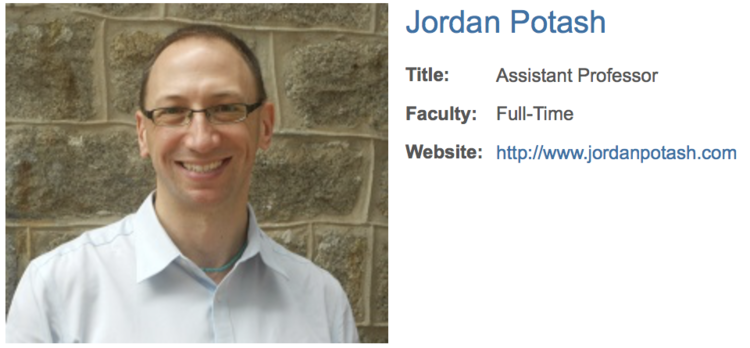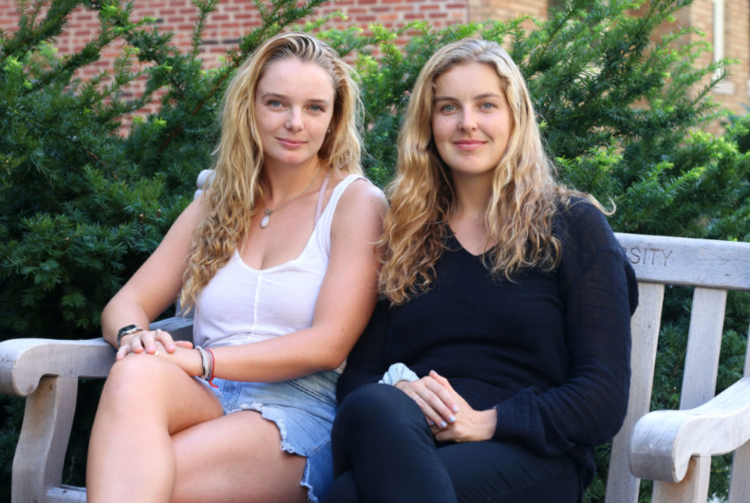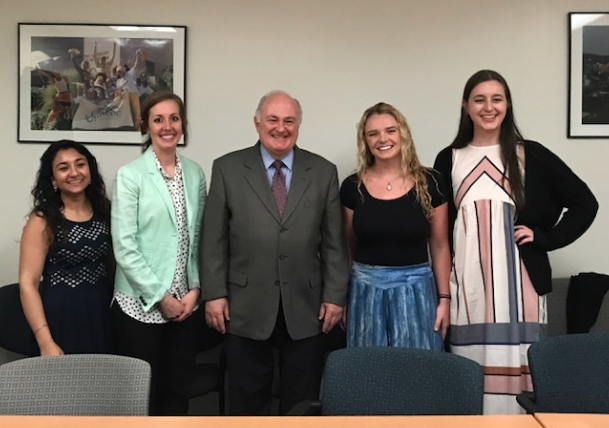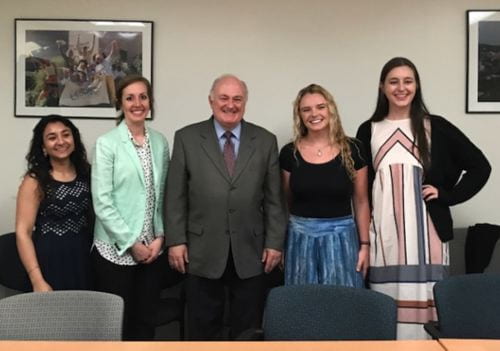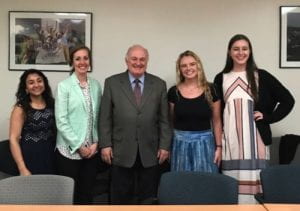Yuval Lev, a Community-Engaged Scholar with the Nashman Center, sat down to talk with Dr. Tara Scully from the GW Biology Department about her scholarship of engagement. Dr. Scully is a member of the Nashman Affiliated Faculty and leads the "Oyster Alley" Project. She teaches "Food, Nutrition, and Service" and "Understanding Organisms Through Service Learning." Click here and here to read more about her classes.
Yuval Lev (YL): Generally, how do you think that community-engaged scholarship and service-learning
impact students when you incorporate them in your curriculum?
Dr. Tara Scully (TS): It’s been very helpful both from the student perspective and the university perspective because so many people think of biology as being something far removed from who they are, what they do, and they don’t understand what biology is. So it’s been a really effective way of teaching students how much of their life is biology and it isn’t something that is just done in laboratories. It’s something that happens all the time, around them, to them. The university kind of pushed back, initially, which I thought was interesting, about incorporating it into a biology class, but I say, “Life, that’s what we study in biology! How could we not incorporate that?” I struggled with hitting home the issues that surround us but aren’t in our face.
The struggle of food insecurity and food deserts in my nutrition course, we talk about that. Those are topics that we connect to our service a lot - how challenging it can be to eat well. There’s this assumption that people are eating poorly because they want to and my students, in their service, have found it’s not true. When given the option, people will choose the right thing. It’s just that they don’t normally have that choice.
Being able to teach those lessons without having to say it – saying it is not going to help. I could talk about it until I’m blue in the face but it’s not going to change their opinions about what’s really happening both in the United States but also globally regarding these issues. These students in the next generations are going to have to deal with these issues on a global scale, where they can’t ignore it. And it’s going to mean a different thing in a different country than it does for us. So I see that this could potentially get very large in terms of where service can go. Local is an important place to start, but it motivates students to move to the global arena to help.
Even in my ecology courses, I’ve had students who’ve done service. They’ve seen the issue
of pollution firsthand and that’s something that you see on TV. When you see this trash, it’s there and disgusting and it’s clogging up the waterways of poor neighborhoods - and it’s purposely in poor neighborhoods versus wealthy neighborhoods. Why is there that difference and what can we do to prevent that?
They’ve gone on to see that they can get jobs that help with those situations. It’s not just that service is the only avenue. There are careers in this and I think that’s helpful for them to see - that service is an avenue of volunteering, to a certain degree, but for a future sense of happiness in their jobs. A career that is going to provide that happiness where it’s not disconnected from service.

YL: There’s a tendency to be objectivists both in GW, higher education as a whole, and other aspects of society, and say, "We’re only going to teach you what’s objective, and about biology, and not insert politics into it." The dilemma is that there already is politics into it and not talking about it only helps the people that are already winning without inserting any other politics into it. From what you’re saying, you’ve seen examples of students in the classroom, and they see this theory, they kind of get it, but then they really see this person that’s affected by it, and it changes their mindset. I want to ask you if you think there’s any way the school, whether CCAS or any other part, can improve in allowing these opportunities?
TS: It is a controversial question but I will answer it because I think it’s necessary. If you’ve met the service-learning teachers, and you have, you’ll know that we work a ton. I teach 400 students in 3 different classes. My service class is only 100 and it takes up the most of my time. It’s because we have to forge partnerships. We don’t just insert people into Miriam’s Kitchen and Martha’s Table. Those are great partners, but we forge relationships with apartment buildings, community centers, places that aren’t necessarily straightforward and easy relationships to build. It takes up a lot of our time, our nights, weekends, afternoons, family time, and that’s hard, because it’s not really recognized by the university. They act as if my service class of 100 students would be equal to a laboratory class with 100 students, and it’s not even close to being the same thing.
Recognition, by and large, is the biggest challenge for us because it makes a difference in your annual report, that they recognize that you’re doing these activities. Without recognition your motivation can be deflated. And it happens every year, where you sit there and you’re like, “But I’m doing so much!” I run into all the other service professors at night, walking to the Metro at the same time, at 9:30 at night, because we’ve been here all day and all night. And we just kind of laugh and point at each other and say, “See you next time!”
Even just words, words are meaningful! If they highlighted the service, and not just from the Nashman Center – it has to be from our schools, it has to be from our colleges, our departments, it has to be systemic that this recognition occurs. I love the Nashman Center. I think it’s great! I’m so happy that we have it and it’s been transformative in terms of how it’s supporting us in a different way, which is helpful, but the recognition can’t just come from there. That’s what the Center’s job is, but everybody else has to recognize that these professors are working really hard and it would be nice to get acknowledged.
YL: One of our Faculty Learning Committees (FLCs) is looking at annual review, tenure processes, evaluation and promotion - the current system is creating an institutional incentive structure that has some people that want to do service feeling like it isn't valued. The FLC is trying to change that. We are also trying to shine a light on service and embed that into people’s minds in a positive way
to promote more service - it also makes the University look good!
TS: Yes, this is important work. For instance, I’m working at an apartment complex in Alexandria where they’ve set up an after-school program for the children in this complex because it happens to be a place where they just put all of the poor people in Alexandria. And the kids can’t stay at the school because it’s too far away for them to stay there and later get bussed back to their apartment complex. So having it at the apartment complex is going to be very helpful. They were awarded a grant to do this. I’ve already been working with Alexandria, and they said, “It’s so exciting that we’re going to do this, continuing working with GW.” And now we have the GW medical program, at T.C. Williams, in Alexandria as well. So in the city’s mind, GW is really making a difference in our city. But you would never know all of the things that we’re doing if you didn’t talk to the city. I don’t think GW knows what we’re doing there.
YL: So the city has recognized the impact – they have no choice but to see it.
TS: Right, they can see it. But they’re also struggling with this issue of, does GW really understand what everybody in the different wheelhouses are doing and what does it mean for us to get involved there and really support those projects? So it’s interesting to see how it plays out. It’s important to say that by doing these small programs, by doing these small things, it’s always from a PR lens. How do we promote that we’re doing cleanups of the Anacostia River from a PR lens? Is that something that we really want to promote that we’re doing? Probably not. My students started composting, just in the biology department, but because
we started a composting program and we talked to other students about it, and they got mad that we’re not doing composting at GW, guess what happened?
YL: They pressured GW to do it.
TS: Yeah, exactly. It makes an impact. From a PR lens, that’s an amazing story. A service class caused this ripple effect on our own community, which is going to have an effect on our larger community, but it’s not going to be written up. Those students deserve recognition. I went on an Alternative Breaks trip to Costa Rica. And every single one of those students I’ve talked to, they’ve brought their compost to me - they’ve said how easy it is. It’s really not that hard. They owe me nothing. I loved my experience with them, I thought it was incredible and I wouldn’t have wanted another group of students. But they don’t owe me anything, they don’t have to bring their compost, but they do it anyways, and that’s so cool.
YL: That’s the kind of thing, where if you give people a nudge, they’ll show up.
TS: Yeah. And they’re nudging their roommate, and someone else, and saying, “Oh, it’s so easy! There’s literally a garbage bin and you drop it off and you’re good. Or the University has their pickups on Fridays.” This is really neat that this has occurred because of this service class, because they were interested in this. GW can be pushed, and I think that’s the good news story about the composting, or the greenhouse. We have this amazing greenhouse, of course, in SEH, but we have a perfectly fine old greenhouse here. We use it for our classes. But I decided, since we have so many different school gardens in D.C. that aren’t used, and we had community partners that always asked us if we had seedlings, that we’d just start growing stuff.
And now we have a growing program. It’s because we have an extra greenhouse that we’re able to sustain it, and it’s something that would’ve sat barren otherwise. We don’t need both of them for the teaching. Now, we’re utilizing one completely for service. Now we’ve expanded it and we’re working with THEARC. They’re doing an outdoor training with a storm water garden. We’ve grown from last semester to now, over 1,200 plants.
We have embedded with Corcoran School at a place called Art Reach, and we have a grant with the school, the Washington School for Girls, and THEARC as a whole, to help with storm water issues. So we’ve been doing cleanups every month. We’ve been doing educational programs with the girls and they’re going to be implementing art programs with the girls this semester. Plus there’s an outdoor garden, and all of the plants I mentioned and stuff. So there’s a lot going on with THEARC that we’re doing, but you maybe wouldn’t know it.

TS: In general, I don’t like to just do a hit and move on relationship with these partners. I plan on continuing to work with the Washington School for Girls. It was the most amazing thing seeing them, last summer, going into the water for the first time, when some of them who had never been into the stream or a natural water body at all. And it was so impactful to my students to understand the meaning behind having a clean stream in your backyard that you can access, that is enjoyable and fun, and that many of us have taken for granted growing up in areas where you did have clean streams, you didn’t have garbage floating down the stream, and it’s amazing the amount of trash that we’ve picked up from that area. I think forging new relationships, and the partnership with Alexandria that I mentioned is an interesting project, along with a project that we have in Fort Chaplin apartment building, which is another apartment building in Northeast D.C. – they’re trying to do the same thing. They’re trying to get the community together, help educate people, help wherever there’s a hole in the system.
So those kids go to very poor public schools. Drew Elementary, which is another school that I’m working with this semester as well, a lot of those kids go to Drew Elementary. They don’t have after school programs necessarily, so the apartment complex and management system realizes that we’ve got to do something with our community. We can’t just let them hang out, we’ve got to do something. So they’re implementing school programs for them that help with tutoring, help with the homeschooled kids, and I think that’s so creative for a management company to think about that. This isn’t even tied to the city, this is the management company working to better their community, because they also think about
the bottom line, which is retention.
You’re going to retain people in places where they feel safe, where they feel comfortable, where they feel like they’re going to get some benefit by living there. So it makes sense on their end, but it’s a lot of effort. It’s not an easy task. Drew Elementary, which also has a VISTA person up there, we’re going to start working on their community garden because they need some help and we’re going to start planting some stuff up there and hopefully work with them.
We hope you enjoyed our interview with Dr. Scully. For a biography of Dr. Scully and other Nashman Affiliated Faculty, check out our Nashman Affiliated Faculty page. Keep your eye on this site and our @NashmanFaculty Twitter account for more great content!
